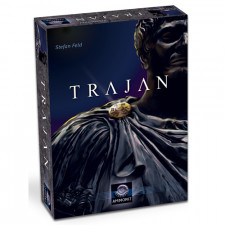Trajan Review
on Sep 10, 2015
You may know Stefan Feld as the point salad guy, but in truth, he's made a career out of designing complicated-looking games that play out in very simple ways. From La Isla to Castles of Burgundy, his specialty is taking an intricate mandala of interlocking actions and parallel paths to victory, then using random mechanisms like dice, cards or cube draws to prune your turn-by-turn decision tree into something much more palatable.
By this metric, Castles of Burgundy may be his best game. But among a certain discerning crowd, Feld's best games are the ones that lack that randomizing factor, that leave the full spectrum of choices in the players' reach. In the Year of the Dragon was one such heavier-than-expected Feld game, and Trajan is another.
Of the two, Trajan is sure to have the widest appeal. It's far less punishing, retaining that point salad appeal that has defined all of his recent releases—while the best player will almost always win, it's impossible to come away without a tidy sum of victory points, no matter how badly you bumble through it. Furthermore, while the addicting mancala mechanism driving the game is completely divorced from the influence of chance, allowing expert players to strategize with Chess-like precision, it's inscrutable enough that it might as well be totally random where most players are concerned. That means it's completely possible to think of Trajan as the Roman cousin of Castles of Burgundy, pretending that it's luck, not choice, that limits your decisions each round.
It's a measure of how quickly trends change in board game design that Trajan's mancala-inspired action selection mechanism no longer seems as groundbreaking as it did in 2011. You can find evolved versions of the same concept at the heart of Five Tribes and Theseus: the Dark Orbit, to name a few. In Trajan, you begin the game with 12 cubes in 4 colors evenly distributed across a circle of 6 bowls (not actual bowls, sadly, although the player boards do give a nice illusion of depth). Each bowl corresponds to one of the game's 6 possible actions. At the start of each turn, you must pick up all the cubes in a single bowl and redistribute them in a clockwise fashion around the circle, dropping a cube of your choice into each bowl one at a time until you run out. Whichever bowl your last cube ended up in, that's your action for the turn.
It's not hard to look at a group of 5 cubes and mentally predict which action you'll land on, but as soon as you take one action, the entire distribution changes. At one point in every game, you'll find yourself with all of the cubes clustered into 3 groups, all ending on the same action. Your job is to make sure that happens with the right action at the right time, to strike a balance between the urgency of taking a particular action—almost every option provides some incentive to get there first—and setting up your mancala for future rounds.
It's hypnotic and supremely satisfying when you learn how to chain actions together with perfect timing, and it's just as interesting when you lose control of the cup game and have to puzzle out how to best exploit an extremely limited range of choices. In the end, the mancala is just a fraction of the game, the glue holding together what amounts to a collection of simple minigames—but bound together, they become much greater than the sum of their parts.
Trajan has what you might call a pasted-on theme, something involving Roman senators, public works projects and fish trading. Yeah, the mechanisms could have paired just as well with an industrial or sci-fi setting, but at least the visual design of the components go a long way toward tying together theme and mechanics.
So go ahead and picture yourself as a Roman senator, idly playing around with a few colored stones while gazing out at the expanse of the empire. The first landmark in your sightline is the Senate itself. By choosing this action, you advance your political standing, pushing your disc forward on a linear track. At the end of each season, you'll be rewarded with victory points based on your position in the senate, and the two highest-ranking senators will get to pick special bonus tiles to use for end-of-game scoring.
Slightly beyond that is the Arch of Trajan. Here, you can take one of six varieties of Trajan tiles and add them to your mancala. These are the reason for the colored cubes: if, when you finish placing your cubes, the bowl contains the two colors shown on the Trajan tile next to it, you can collect the tile and use it for an immediate benefit, an enhanced action later on, or some bonus scoring points.
Next, you see the Forum. At the beginning of each season, this is randomly filled with bonus tiles, free to the first comer. Some tiles give you bonus actions, others act as wild cards, but most are used to meet the people's demands at the end of the season. Each season, the people will clamor for food, entertainment, or religion, and you must try to meet their needs—fail, and you suffer a moderate-to-severe point penalty based on how many needs you failed to meet.
These are the simpler actions. The port, visible in the near distance, lets you draw and/or discard cards showing various trade goods. You're going for a few set collection bonuses: each season, three ships will provide handsome rewards to the first senator who brings sets of identical, unique, or paired goods. Latecomers get paid, too, but not nearly as well.
Farther off, you can see the districts of Rome that are still being rebuilt following the great fire of AD 80. Here, you can recruit workers to the worker camp and send them off to rebuild specific structures, branching out in a linear fashion. This is another set collection opportunity, with big points available for collecting all 4 structures of a single type, but the competition is fierce, since these spaces do not refill at the end of the season. And each time you scoop up a structure, you immediately get to perform an associated action elsewhere on the board.
Finally, as though in a dream, you can see the distant provinces of the empire, lands like Germania and Britannia. You'll send your legionnaires marching through this small map, collecting additional forum tiles as tribute, but the ultimate goal is to occupy the highest-scoring territories at the far end of the map. Again, to get the best reward, you'll want to get there first, since these spaces offer diminishing returns.
None of these minigames sounds like anything special, but they mesh together beautifully, your actions in the Forum helping you grab a Trajan tile that lets you move your legionnaires further into the territories. In particular, the ever-present emphasis on timing, combined with the trickiness of the action-selection mechanism, makes this an engrossing puzzle you won't stop until you've mastered.

 Customer Support
Customer Support  Subscribe
Subscribe 




 Account
Account  Wishlist
Wishlist 

